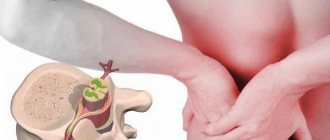Many pathologies are characterized by severe symptoms. However, in their absence, a person’s reflexes may indicate the presence of the disease. This is especially important when the patient is too young to describe symptoms in words.
Babinski's symptom is one of the most important, albeit pathological, reflexes. It is described as an abnormal response of the central nervous system to an irritating mechanical stimulus. Which is not only an indicator of a disruption in its functioning, but also the consequences of other equally serious diseases.
What is Babinski's sign?
A person's involuntary reflexes, controlled by his nervous system, are the brain's response to various stimuli. The value of this kind of data for making a diagnosis is that a person cannot manage it independently. It is not possible to hide such a reaction, whether intentionally or not.
Any qualified neurologist knows what Babinski’s symptom is. For people without medical education, it can be difficult to understand its meaning. It is necessary to have a general understanding of the functioning of the human central nervous system, its perception of external signals, methods of processing and output.
Under the influence of external stimuli, nerve endings form impulses that are transmitted to the brain. Analyzing the information received from them, it issues response impulses. Simply put, commands for skeletal muscles with an algorithm for further actions.
Depending on the situation, this could be:
- jerking;
- redistribution of equilibrium;
- block on muscle activity;
- flexion;
- extension.
Babinski's sign is a reflex, which is a pathological reaction of the toes, accompanied by their extension. The peculiarity is that normally, when a certain area of the foot is impacted, a command should be received to bend its muscles downward. The above symptom has age-related exceptions due to insufficient development of the cerebral cortex.
After carrying out manipulations to test the reflex, the result can be positive or negative. In medical practice, there are cases of false-positive interpretation of the result, which were subsequently not confirmed by additional diagnostic methods.
https://www.youtube.com/watch?v=FWrVB_2U5bY
The concept of pathological reflexes in neurology
In neurology, a reflex is understood as the body’s reaction to any irritation localized in the reflex zone, which comes from the outside.
The presence of reflexes allows us to judge the state of health of certain parts of the human central nervous system. The studies of reflexes are limited to establishing their uniformity, character, symmetry, frequency and intensity.
With the normal development of the human body, reflexes at different life stages arise and disappear independently. They are divided into conditional (which are acquired during life) and unconditional (which are present from birth).
In the absence of congenital reflexes, the presence and development of a certain disease is understood, which in most cases is classified as neurological.
Pathological are those reflexes that appear as a result of damage to the main neuron, which is localized in the structure of the brain, neural pathways and nuclei of the cranial nerves. It is these structures that are responsible for the correctness and sequence of motor acts.
Any damage to these structures leads to the body producing unusual reactions in the form of various movements. Typically, such reactions are considered not normal, since they are quite different from the reflex reactions of a healthy person.
Mechanism of occurrence
What Babinski's symptom is can be understood by studying the mechanism of its occurrence. An impulse entering the brain with information about the presence of a stimulus in the foot area is analyzed by cells of the cerebral cortex.
In Betz's pyramidal cells, a response, motor or inhibitory impulse is formed, transmitted along the descending pathway. As a result of this process, the muscles of the foot contract, indicating a positive or negative result.
The path that ensures the delivery of the response signal to the skeletal muscles is called the pyramidal nerve tract. When the impulse has passed through the ascending path to the brain and descending along this tract without obstruction, the toes bend down towards the foot. Such a reaction to an irritant is considered normal.
We can talk about a pathological Babinski symptom when the result is the opposite. Namely, the thumb is extended, the rest are spread wide to the sides, forming something like a fan in shape.
What are the reflexes?
In a normal situation, all reflexes appear and disappear in their own time. They are divided into congenital (unconditional) and acquired (conditional). The first ones are always with us, their loss means illness. As for the second group, some of them are lost with age, others appear. If the presence of a reflex is not typical for a given period of a person’s life or there is an increase (weakening) of it, this is a pathology that falls within the scope of activity of a neurologist.
It is important to be able to correctly evoke and evaluate reflexes, so this should be done by specialists who can distinguish physiology from pathology. Pathological signs in neurology always mean illness and occur when the pyramidal system (central motor neuron) is damaged.
Both unconditioned and conditioned reflexes can be pathological. Acquired (conditioned) reflexes are considered a pathology if they cause an inadequate response to a simple stimulus. The pathological nature of congenital reflexes is said if they do not fit into the neurological status of a given age or are inappropriate from a biological position.
In the practical work of neurologists, various unconditioned pathological reflexes are studied, indicating damage to the connections between the brain and spinal cord. Most often these are signs from the lower extremities. The response to the stimulus is manifested in the extension of the first toe (extensor reflexes) or the flexion of all toes (flexion group). The main pathological extensor reflex is the Babinski reflex.
What does one-sided and two-sided reflex mean?
In medical practice, there are cases when a pathological reflex is observed on both feet of the patient. In an adult, this situation indicates the severity of the disease that led to this result. In most cases, these are infectious or inflammatory processes occurring in the spinal cord or brain, affecting its central motor neuron.
Below are a number of diseases in which bilateral Babinski's sign often appears:
- meningitis;
Meningitis in adolescents. Symptoms - spinal cord tuberculosis;
- chronic progressive diseases of the central nervous system;
- spinal paralysis;
- head injuries;
- increased intracranial pressure;
- damage to the pyramidal tract;
- rabies.
Early detection of the symptom is important. This is due to the fact that many diseases have a high rate of development. The consequences of delaying diagnosis and treatment of the disease lead to irreversible consequences for the patient’s body.
To complete the clinical picture, in addition to the Babinsky reaction itself, accompanying signs are taken into account, with the help of which the lesion can be more accurately determined.
Associated signs of damage to the brain or spinal cord:
| Sign | Spinal cord | Upper motor neuron |
| Reflex response | Fast and pronounced | Slow and tonic |
| Big toe extension | Long-term | Short term |
| Paresis | Proximal | Distal |
| Superficial abdominal reflexes | None | Fine |
| Other signs | Pelvic disorders | Hyperreflexia, synkinesis |
It is not possible to make a full diagnosis based on reflexes and signs alone. However, this is enough to determine the direction of further diagnosis and early detection of diseases.
Symptom research in adults
If a child’s Babinski symptom is present until a certain age, it does not indicate the presence of health problems, but such a manifestation of symptoms in an adult fully confirms the presence of neurological pathologies.
In an adult, the pathological Babinski reflex can manifest itself on only one side and be bilateral. Its presence proves that the connection between areas of the spinal cord and brain is altered or disrupted.
Such a symptom may exist for a certain period of time (for example, after suffering attacks of epilepsy) or be permanent (then they speak of severe lesions in the pyramidal tracts).
In addition, the Babinski reflex can be caused as a result of various neurological diseases and chronic ailments. The list is long, but the following pathologies pose a particular danger:
- Charcot's disease (an illness associated with damage to neurons and loss of their functions), the consequence of such a disease is the development of paralysis and atrophy of all muscle groups;
- diagnosing tumors in the brain;
- genetic predisposition (in particular, Friedreich's ataxia);
- previous head injuries;
- stroke;
- diagnosing liver failure and encephalopathy;
- diseases of a chronic nature, the greatest danger is represented by multiple sclerosis, it is during its course that the first sign of the disease becomes Babinsky’s symptom;
- negative complications of meningitis;
- anemia of malignant origin;
- viral infections (rabies);
- received back injuries;
- diagnosing tumors in the spinal cord;
- tuberculosis localized in the bones, spinal cord and spine;
- syringomyelia syndrome.
Cause of pathology
Certain brain cells are responsible for forming and sending impulses. They also control the inhibition of constant motor impulses of neurons in the anterior horns of the spinal cord.
It is thanks to the constant inhibitory impulse that pathological muscle contractions do not occur. Based on the mechanism of occurrence of Babinski’s symptom, it follows that the causes of the pathology can be disturbances in the functioning of the central nervous system of various types:
- injuries;
- infections;
- congenital developmental anomalies;
- inflammatory processes;
- hemorrhages;
- tumors of various types;
- sclerotic changes;
- tissue swelling.
Not only the nature of the lesion is distinguished, but also the place of its occurrence. The source of the disease can be located both in the brain itself and in the fibers of the spinal cord. This pathological reflex can be interpreted ambiguously when the patients are children, especially those under two years of age.
In newborns
Babinski's symptom in newborns and children under 2 years of age is not always a pathology. The positive reflex in this case manifests itself for physiological reasons. Namely, the weak development of the cerebral cortex, its cells responsible for the formation and processing of impulses.
At this time, the central nervous system, including the pyramidal tract, is just beginning to improve the system of transmitting impulses to the brain and back to the source of the stimulus.
In other children
As a child grows up, all systems of his body develop and improve their functioning. In cases where the child is 2 years old or more, the appearance of an extensor reflex may indicate a disorder. For a pediatric neurologist, the presence of this symptom will be the basis for regular examinations and monitoring of the patient over time.
On the one hand, each organism is unique, and the time required to debug all processes in it may vary. On the other hand, the sooner a symptom is identified, the more complete an anamnesis a specialist can make. This means performing additional diagnostics, scheduling consultations with other specialists, taking measures to prevent the progression of the detected disease, and prescribing the correct treatment.
In adults
Unlike children, in adults Babinski's symptom is always a pathology. If it is identified, a further set of measures will be aimed at diagnosing the cause and severity of the disease.
Causes of Babinski's sign in the brain and spinal cord:
| Brain | Spinal cord |
|
|
The pathological conditions listed in the table are not the entire list. There are diseases that can develop in both the brain and spinal cord.
Having a detrimental effect on their structure and functioning, for example:
- multiple sclerosis;
- tumor;
- cyst;
- injuries;
- infections;
- destruction of the membrane of neurons.
The manifestation of Babinski's sign on two feet may indicate a severe degree of the disease or the presence of several foci.
Diagnosis in neurology
To establish an accurate diagnosis, a specialist should pay special attention to the following issues:
- Careful collection of medical history of the patient and his family members (importance is given to genetic predisposition to neurological pathologies).
- Clinical laboratory blood tests.
- Carrying out all necessary medical examinations.
- Diagnosis of abnormalities in the functioning of the central and peripheral nervous systems.
Diagnosis of abnormalities in the functioning of the nervous system can also be carried out using the following methods:
- Electromyography . During the procedure, the neuromuscular synapse, as well as primary and secondary myopathies, are studied. Both the facial nerves and the endings of the upper and lower extremities are examined.
- Nerve conduction study procedure . Allows you to evaluate the speed of impulse conduction between motor fibers and stimulating points. If the results show low numbers, the doctor may assume the development of demyelination.
- Electroencephalography method . Most often recommended for studying epileptic seizures. In some cases, it is used to confirm the presence of damage to the human cerebral cortex and various somatic pathologies.
- Lumbar puncture.
- Magnetic resonance imaging and computed tomography.
No medical equipment is required to diagnose the Babinski reflex in newborn infants. To confirm the diagnosis, the neurologist will only need a hammer, which he will use on the outside of the sole. In this case, there should be a slow extension of the thumb (the rest at this moment should remain motionless).
How to test your reflex at home?
Babinski's sign is one of the simple reflexes that does not require complex equipment or instruments to test. That is why it is available to everyone at home.
The procedure algorithm is as follows:
- The patient is positioned horizontally on a couch or bed, lying on his back. At the same time, the leg muscles are relaxed and the toes point upward.
- Holding the foot above the ankle joint with a non-sharp object (pen, pencil, toothpick with a cut off sharp edge), draw strokes along the outer edge of the foot.
- The direction of movement of the instrument starts from the heel to the ball of the foot, turning towards the big toe.
- The procedure is performed alternately on both legs. Pressing the selected tool should not cause pain.
An important point when checking the reflex is the integrity of the skin of the foot and the absence of injuries. If there is damage, the result may be incorrect.
Checking your reflexes at home can be a signal to contact a medical facility. Do not forget that only an experienced neurologist, taking into account the totality of all symptoms and signs, is able to give an adequate assessment of the situation.
Diagnostics in a medical facility
Babinski syndrome is the body’s first signal about the need for examination by a neurologist. The method of conducting a reflex test at home and in a medical institution differs only in the presence of a qualified specialist.
Experience and knowledge that allows us to take into account the general condition of the patient, various accompanying signals of the human body and decipher them. Despite the fact that the reflex itself already indicates the presence of pathology, a specialist can make a full diagnosis only based on the results of a complete diagnosis.
One of the first methods is laboratory and may include the following list:
- general blood analysis;
- biochemical;
- immunological tests.
There is another laboratory test for diagnosing diseases with the Babinski reflex. It differs from those listed above in its complexity and greater information content. A lumbar or lumbar puncture allows you to examine the composition of the fluid from the spinal cord.
Fluid is collected by a neurologist or an anesthesiologist in a medical facility. Sometimes the procedure is carried out for medicinal purposes. Removal of excess cerebrospinal fluid (cerebrospinal fluid), administration of medications for neuroinfections and oncology.
To study the condition of the blood vessels of the brain, its structure, and possible changes, cerebral angiography is performed. The essence of the procedure is to administer a contrast agent and further monitor its passage through the vessels of the area under study.
Upon completion, the patient receives several pictures and a video recording the results. To examine the spinal column, vertebral angiography is performed.
Diagnostics using magnetic resonance and computed tomography will help to exclude such causes of Babinski's symptom as:
- tumor compressing nerve fibers;
- tissue swelling as a result of injury;
- intracranial hematoma;
- other changes in the structure of human organs.
These methods are similar in information content, but MRI shows tissue more clearly, and CT results show bone structures. The most appropriate research method is selected by a specialist based on the medical history.
Positive result
Neurologists call Babinski's positive sign a reflex extension of the big toe, as well as a fan-like spreading of the others wide to the sides.
Experts consider this response of the central nervous system in adult patients and children over two years of age to a stimulus to be a sign of disorders.
Negative result
A negative result when testing for the Babinski reaction is considered normal. That is, a reflex contraction of the skeletal muscles of the foot to compress the toes during line irritation of the skin on its outer side.
False result
A false result or pseudo Babinski reflex occurs with peripheral paresis of the toe flexor muscles in neuropathy and myopathy. This reaction is caused by disruption of the tibial nerve and, as a consequence, paralysis of the flexor muscles.
Often, a false result means the presence of a symptom in newborns, however, experts do not use such a term in such cases. Since the presence of a positive reflex due to the patient’s age is considered normal.
Diagnostics
As a rule, a positive Babinsky test is the result of a special examination performed by a neurologist. After all, people themselves without medical education may not even be aware of the presence in their body of a failure of the impulse to the skeletal muscles.
In order to clarify what was the root cause of the pathological symptom, it will be necessary to carry out a number of clarifying diagnostic procedures:
- various blood tests - general, biochemical, for autoimmune processes;
- angiography of cerebral vessels - previous headaches may indicate vascular lesions, for example, atherosclerosis with foci of ischemia;
- magnetic resonance imaging - changes in the nerve impulse due to compression of the fiber by a tumor, traumatic tissue edema, intracranial hematoma;
- spinal puncture to take cerebrospinal fluid for examination - to rule out an infectious lesion of the system;
- according to individual indications - tissue biopsy, more precisely the motor roots of the spinal cord, for the purpose of differential diagnosis with cancer.
Only after careful comparison of information and analysis of research results, a neurologist will make an accurate diagnosis and select effective therapy.
What to do if Babinski's reflex is detected?
At the first symptoms and suspicions, consultation with a specialist is necessary. The task of a neurologist is to conduct the most detailed examination of all human reflexes. Based on the totality of signs, you can understand what diagnostic methods need to be applied.
Indeed, most often in cases of disorders in the brain and central nervous system as a whole, the speed of detection of the disease plays a role. This is important because many of them have a high rate of progression, and the consequences will be irreversible.
Therapy
Babinski's symptom is one of the pathological reflexes in which the therapeutic effect of treatment can occur only if the root cause of its occurrence is discovered.
Based on the results of a complete diagnosis, the doctor can make an accurate diagnosis. Treatment in this case will depend on the identified disease. The main direction of the fight is to prevent complete muscle paralysis due to the progression of the disease.
Depending on the disease, the following treatment methods can be used:
- immunotherapeutic (for mild degrees);
- medicinal (for mild and moderate severity);
- chemotherapy (malignant tumors);
- physical (massage, radio/UHF therapy, electrophoresis);
- surgical (if conservative treatment is ineffective).
The choice of method and treatment regimen are strictly individual for each patient. As a rule, in addition to the neurologist, other specialists in a narrow field of medicine participate in this process, depending on the disease.
In most cases, even with effective treatment, the patient requires long-term rehabilitation to restore lost functions. In severe illnesses, the recovery process is impossible, and the damage may be irreversible.
That is why preventive examinations by a neurologist and other specialists are necessary. A timely detected Babinski symptom for a person is an opportunity to prevent harmful consequences for the body.










